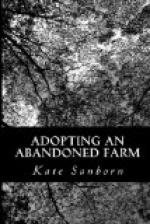Outside, what rare attractions! Twenty-five acres of arable land, stretching to the south; a grand old barn, with dusty, cobwebbed, hay-filled lofts, stalls for two horses and five cows; hen houses, with plenty of room to carry out a long-cherished plan of starting a poultry farm.
The situation, too, was exceptional, since the station from which I could take trains direct to Boston and New York almost touched the northern corner of the farm, and nothing makes one so willing to stay in a secluded spot as the certainty that he or she can leave it at any time and plunge directly into the excitements and pleasures which only a large city gives.
What charmed me most of all was a tiny but fascinating lakelet in the pasture near the house; a “spring-hole” it was called by the natives, but a lakelet it was to me, full of the most entrancing possibilities. It could be easily enlarged at once, and by putting a wind-mill on the hill, by the deep pool in “Chicken Brook” where the pickerel loved to sport, and damming something, somewhere, I could create or evolve a miniature pond, transplant water lilies, pink and white, set willow shoots around the well-turfed, graveled edge, with roots of the forget-me-not hiding under the banks their blue blossoms; just the flower for happy lovers to gather as they lingered in their rambles to feed my trout. And there should be an arbor, vine-clad and sheltered from the curious gaze of the passers-by, and a little boat, moored at a little wharf, and a plank walk leading up to the house. And—and oh, the idealism possible when an enthusiastic woman first rents a farm—an “abandoned” farm!
It may be more exact to say that my farm was not exactly “abandoned,” as its owner desired a tenant and paid the taxes; say rather depressed, full of evil from long neglect, suffering from lack of food and general debility.
As “abandoned farms” are now a subject of general interest, let me say that my find was nothing unusual. The number of farms without occupants in New Hampshire in August, 1889, was 1,342 and in Maine 3,318; and I saw lately a farm of twenty acres advertised “free rent and a present of fifty dollars.”
But it is my farm I want you to care about. I could hardly wait until winter was over to begin my new avocation. By the last of March I was assured by practical agriculturists (who regarded me with amusement tempered with pity) that it was high time to prune the lazy fruit trees and arouse, if possible, the debilitated soil—in short, begin to “keep it up.”
So I left New York for the scene of my future labors and novel lessons in life, accompanied by a German girl who proved to be merely an animated onion in matters of cooking, a half-breed hired man, and a full-bred setter pup who suffered severely from nostalgia and strongly objected to the baggage car and separation from his playmates.
If wit is, as has been averred, the “juxtaposition of dissimilar ideas,” then from “Gotham to Gooseville” is the most scintillating epigram ever achieved. Nothing was going on at Gooseville except time and the milk wagon collecting for the creamery. The latter came rumbling along every morning at 4.30 precisely, with a clatter of cans that never failed to arouse the soundest sleeper.




